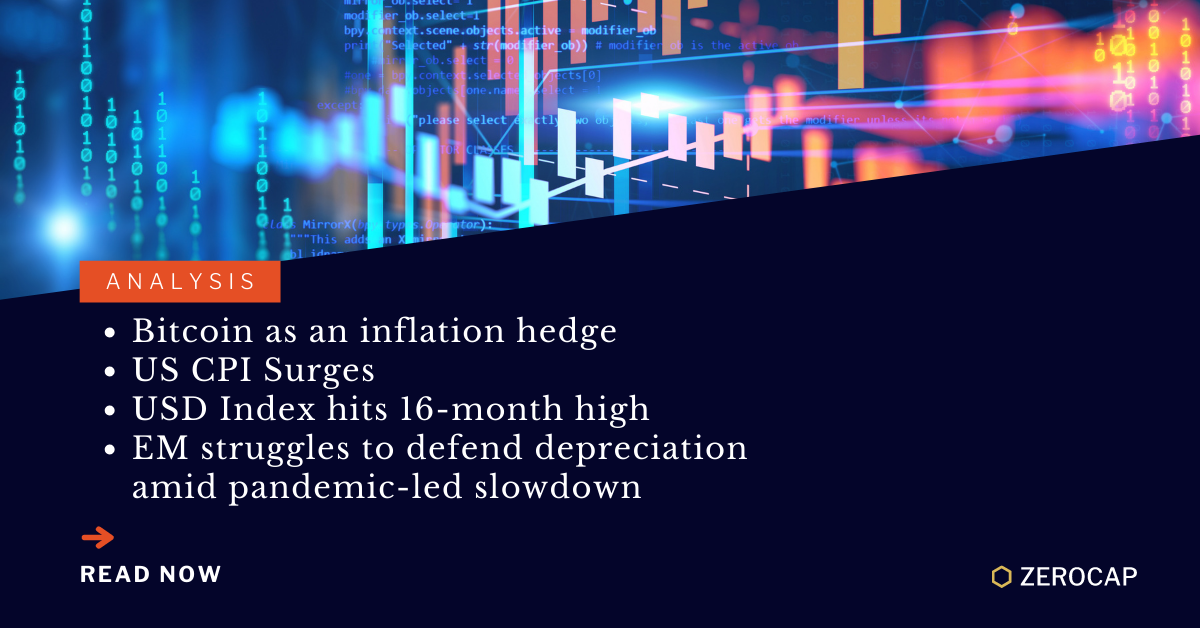Content
- US Inflation
- US Stocks
- EM FX and Global Credit
- Bitcoin as the New Gold
- FAQs
- What factors are contributing to the current inflation surge, and how does it relate to Bitcoin?
- How are central banks' responses to inflation affecting asset markets, including Bitcoin?
- What is the significance of Bitcoin's total supply being capped at 21 million, and how does it compare to Gold?
- How are emerging markets responding to inflation, and what are the potential risks?
- What is the role of Bitcoin in portfolio diversification, and how does it serve as an inflation hedge?
- About Zerocap
9 Dec, 21
Bitcoin as an inflation hedge, US CPI surges, USD index hits 16-month high, EM struggles

- US Inflation
- US Stocks
- EM FX and Global Credit
- Bitcoin as the New Gold
- FAQs
- What factors are contributing to the current inflation surge, and how does it relate to Bitcoin?
- How are central banks' responses to inflation affecting asset markets, including Bitcoin?
- What is the significance of Bitcoin's total supply being capped at 21 million, and how does it compare to Gold?
- How are emerging markets responding to inflation, and what are the potential risks?
- What is the role of Bitcoin in portfolio diversification, and how does it serve as an inflation hedge?
- About Zerocap
In this analysis, Zerocap’s Treasurer William Fong provides important insights on bitcoin as an inflation hedge and the current macro landscape, with a focus on the US and global credit markets:
- Bitcoin as an inflation hedge
- US CPI Surges
- US Index hits 16-month high
- EM currency struggles to defend depreciation amid pandemic led growth slowdown
US Inflation
Expectations are rising fast; the October CPI figures showed a 0.9% month on month spike or 6.2% since this time last year (the highest annual rise since 1990). Market watchers are focusing on the supply chain constraints, in part caused by pandemic lockdowns and travel restrictions, but also due to the ESG push towards greener investments. The first factor shows up in the monthly PPI (Producer Price Index), seeing an annual gain of 8.2%.
The FED and other central bank boards from developed economies would have you believe that once COVID-19 constraints subside, supply-side price pressure would ease, and therefore any inflation spikes are only transitory in nature (though that thought is changing). However, as we’ve seen in recent developments from COP26 in Glasgow, over 200 nations announced the end of fossil fuel dependency over the next ten years; ESG or “Greenflation” is now a major cause of material and resource price hikes.
Simply put, if large corporations and governments are reluctant to invest in new oil drilling platforms (due to ESG concerns and constraints), then we will have less supply (higher prices) going forward (at least until we can harness enough carbon neural natural energy to cater for the world’s energy needs). The bottom line; inflation is here to stay, and it will likely get worse before it gets better.
The response from asset markets so far has been mixed; while US stocks are still hovering at record levels, corporate credit, and emerging market currencies are feeling the strain.
US Stocks
According to the latest data provided by Bloomberg, average PE multiples and buyback levels are at the highest in a decade. With the FED pumping in USD 120 billion a month into the money supply (only beginning to taper off on Nov 21), even with a slowing velocity of money, the impact of leverage becomes a supporting floor to both the US bond and equity markets.
But this is getting shaky, and as one ex-Citibank CEO once said, “we need to dance as long as the music is playing”, the game of musical chairs does not leave much room for asset managers to stop and think about where the risk is hidden. Simply put, the forward earnings ratio is computed by the present value of future expected earnings, and a discount rate is employed for this present value calculation. When cash rates are zero, growth stocks are discounted with an infinite value (something divided by zero = infinite).
However, as central banks begin to normalise interest rates around the globe (RBNZ has hiked twice from 25 to 75 bp, and BoK hike from 75bp to 1% this week), the discount rate will not stay at zero for long, leading to the question of what are these growth stocks worth in today’s dollar?
EM FX and Global Credit
There is contagion occurring through international credit, interest rate and emerging FX markets.
Recent headlines relating to the potential default of Evergrande’s $300 billion of outstanding debt began with the government’s intention to control over-leverage in the economy. That’s because higher inflation expectations lead to higher interest rates and a weaker sovereign currency. Turkey’s Lira (55% depreciation since Sept 21), and Mexico’s Peso (5.5% in 2 weeks) are showing strains. As the USD index (DXY chart below) climbs from the expectation of an earlier FED move, the only way for emerging market (EM) authorities to limit their FX value’s depreciation is by raising the domestic interest rate and hoping outflows would pause.
However, due to the ongoing pandemic, many emerging economies cannot afford to tighten liquidity or raise rates, and therefore risk crowding out the growth path towards economic recovery. To maintain a loose monetary environment, EM economies face massive outflows, and a spiralling course of depreciation as the risk of stagflation escalates. Which once again elevates the default risk of investing in EM economies. A full circle of risk aversion starts to take form.
Bitcoin as the New Gold
History has shown that during the period of high inflationary expectation, or even times of hyperinflation, precious metals with high stock to flow (S2F) ratios (that is, the amount of total outstanding supply divided by the increment of new supplies) equates to a higher valuation, thus representing a hedging tool for portfolio diversification away from equity, bonds, and property.
However, as Modern Monetary Theory proposes, new and inventive monetary and fiscal policy tools are warranted for the new era of economic conditions. Since Satoshi Nakamoto’s white paper on bitcoin was published back in 2008 in response to the global financial crisis, it has become the modern inflation hedging tool against the government and central banks’ ultra-accommodative and extraordinary monetary policy. The fundamental structure behind the creation of Bitcoin by employing cryptography and blockchain technology is to limit the creation of supply and limit the expansion of the money supply in a prudent manner. Bitcoin’s total supply will be capped at 21 million, full stop.
Empirical evidence so far has supported this strict protocol, and according to analytical forecasts, the direction of stock to flow ratios for Bitcoin can only go higher from here. That is not the case for Gold; as you can see from the graph below, the direction of Gold’s supply has fluctuated and is getting more and more abundant. In addition to the S2F comparison, Bitcoin also has a number of benefits over Gold in the real-world sense.
Firstly, there is no storage cost for holding bitcoin; in fact, there are yield returns available for holding Bitcoin at some custodians vs no interest income for holding Gold. Secondly, it is much easier to employ Bitcoin as a medium of exchange over the internet, relative to the physical migration of physical Gold to one another. Chart C below then shows how historical scatter plot mapping using R-squared regression results in a high level of correlation of inflation rates as measured by the US CPI and the price of Bitcoin from 2015 to 2021.
To sum it up, as inflation expectations rise, following a decade of extraordinary central bank stimulus that pushes traditional asset prices to unsustainable levels, Bitcoin certainly serves as an inflation hedge providing an attractive portfolio diversification alternative for investors.
FAQs
What factors are contributing to the current inflation surge, and how does it relate to Bitcoin?
The inflation surge is attributed to factors like supply chain constraints due to pandemic lockdowns, travel restrictions, and the push towards greener investments. The October CPI figures showed a 6.2% annual rise, the highest since 1990. Bitcoin, with its capped supply and increasing stock-to-flow ratio, serves as a modern inflation hedging tool, providing an alternative for portfolio diversification.
How are central banks’ responses to inflation affecting asset markets, including Bitcoin?
Central banks’ responses, such as the Federal Reserve’s tapering plans and potential interest rate hikes, have mixed impacts on asset markets. While US stocks hover at record levels, corporate credit and emerging market currencies feel the strain. Bitcoin’s role as a hedge against inflation and government monetary policy makes it an attractive investment option in this environment.
What is the significance of Bitcoin’s total supply being capped at 21 million, and how does it compare to Gold?
Bitcoin’s total supply is capped at 21 million, ensuring a limited creation of supply. Unlike Gold, whose supply has fluctuated and become more abundant, Bitcoin’s stock-to-flow ratio can only go higher. Additionally, Bitcoin offers benefits like no storage cost, yield returns for holding, and ease of exchange over the internet, making it a more attractive inflation hedge.
How are emerging markets responding to inflation, and what are the potential risks?
Emerging markets are showing strains, with currencies like Turkey’s Lira and Mexico’s Peso depreciating. The risk of stagflation escalates as emerging economies struggle to tighten liquidity or raise rates during the pandemic. This situation elevates default risk and creates a full circle of risk aversion, further highlighting the appeal of Bitcoin as a hedging tool.
What is the role of Bitcoin in portfolio diversification, and how does it serve as an inflation hedge?
Bitcoin serves as an inflation hedge by offering an attractive portfolio diversification alternative. Its limited supply, increasing stock-to-flow ratio, and benefits over traditional assets like Gold make it a modern tool against inflation. As inflation expectations rise, following extraordinary central bank stimulus, Bitcoin’s value as a hedge becomes more pronounced.
About Zerocap
Zerocap provides digital asset investment and custodial services to forward-thinking investors and institutions globally. Our investment team and Wealth Platform offer frictionless access to digital assets with industry-leading security. To learn more, contact the team at hello@zerocap.com or visit our website www.zerocap.com
Like this article? Share
Latest Insights
Weekly Crypto Market Wrap: 31st March 2025
Zerocap is a market-leading digital asset firm, providing trading, liquidity and custody to forward-thinking institutions and investors globally. To learn more, contact the team at
Weekly Crypto Market Wrap: 24th March 2025
Zerocap is a market-leading digital asset firm, providing trading, liquidity and custody to forward-thinking institutions and investors globally. To learn more, contact the team at
Weekly Crypto Market Wrap: 17th March 2025
Zerocap is a market-leading digital asset firm, providing trading, liquidity and custody to forward-thinking institutions and investors globally. To learn more, contact the team at
Receive Our Insights
Subscribe to receive our publications in newsletter format — the best way to stay informed about crypto asset market trends and topics.



 Share
Share  Tweet
Tweet  Post
Post 